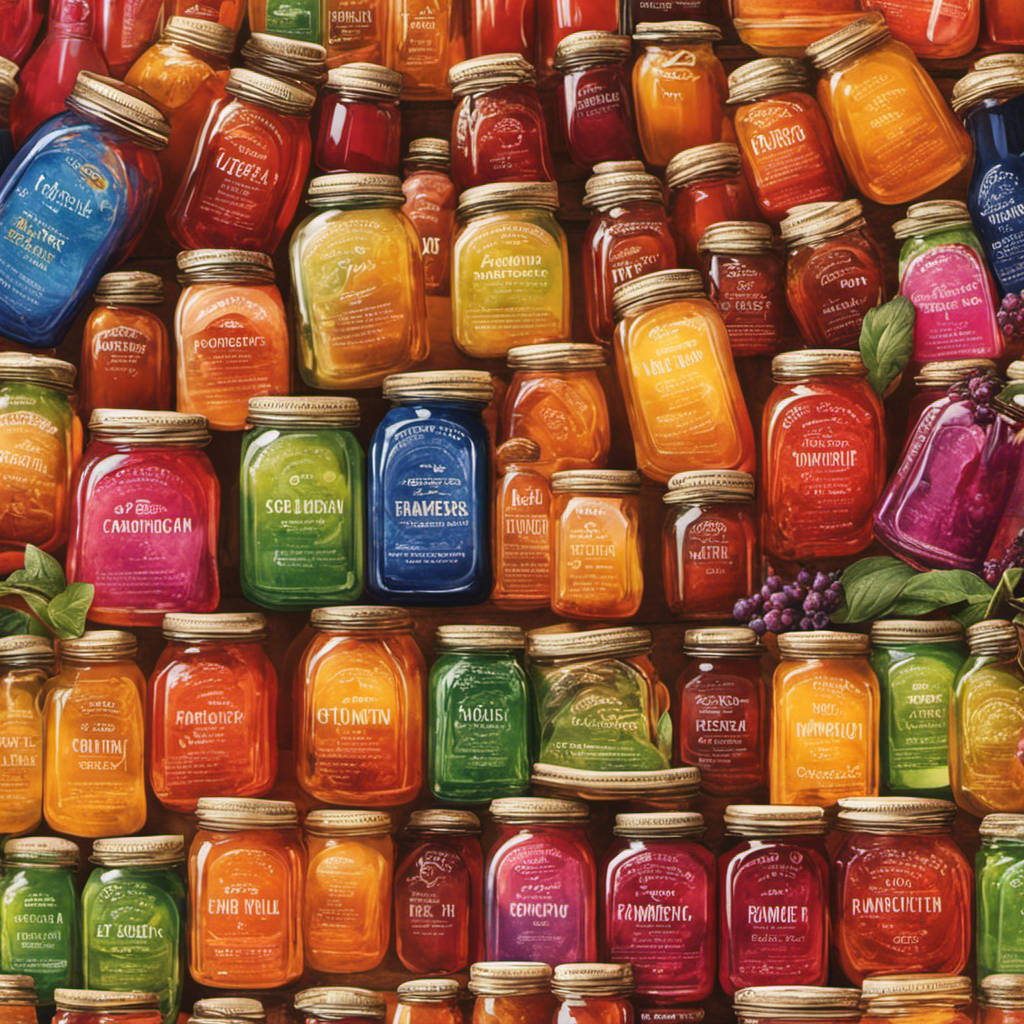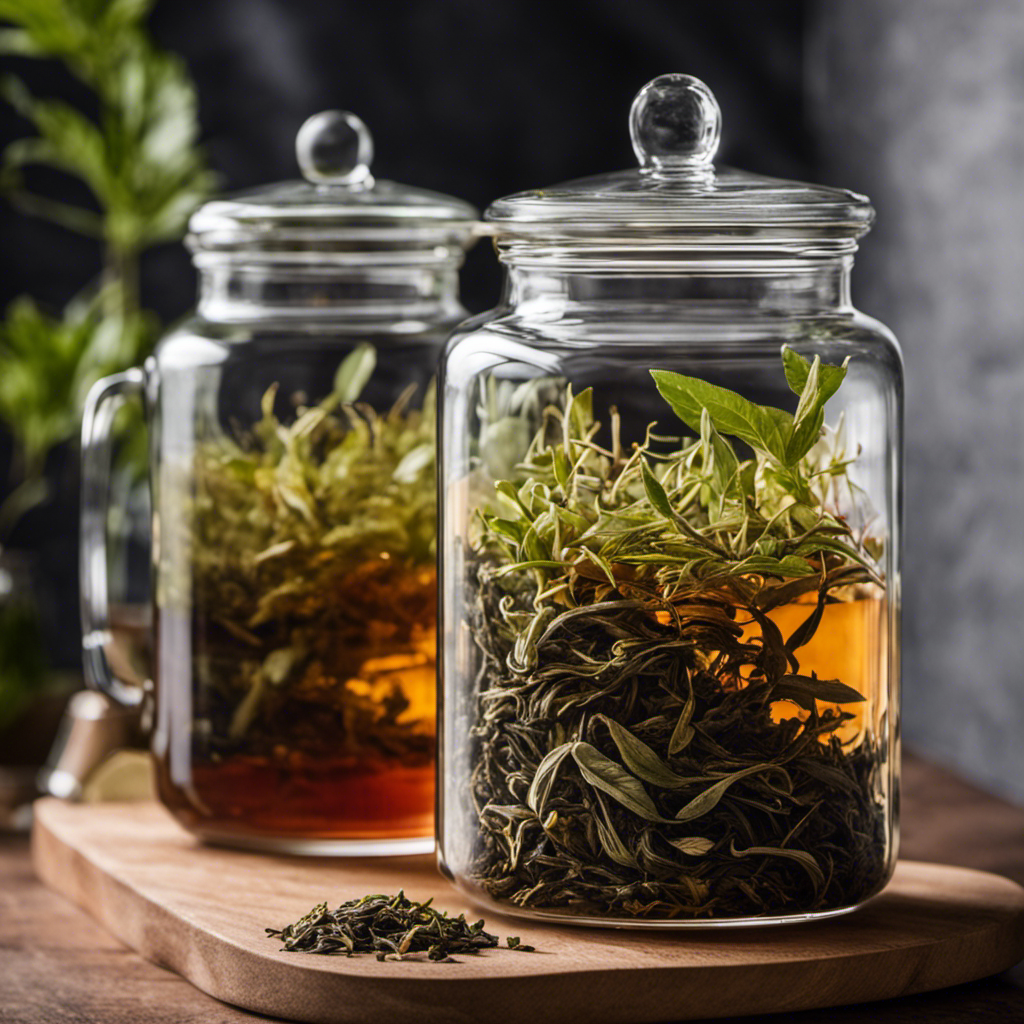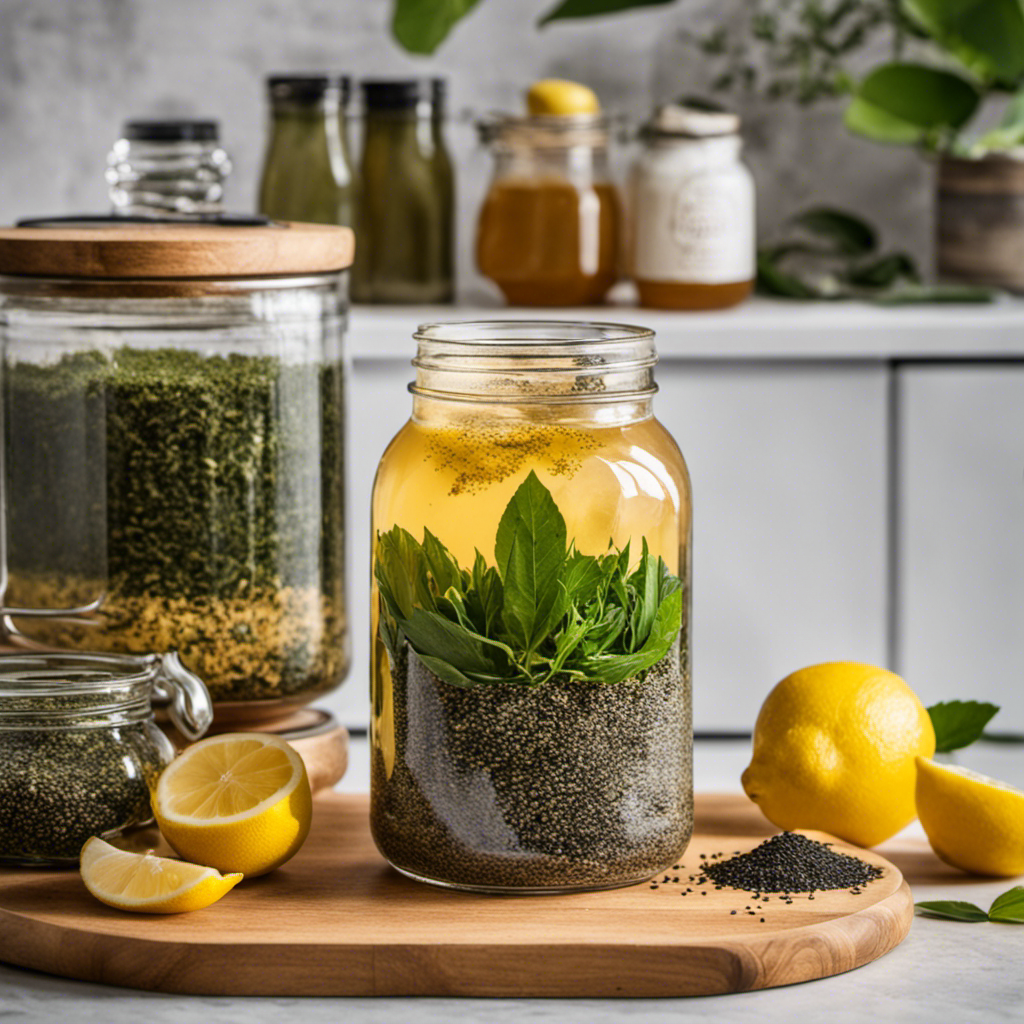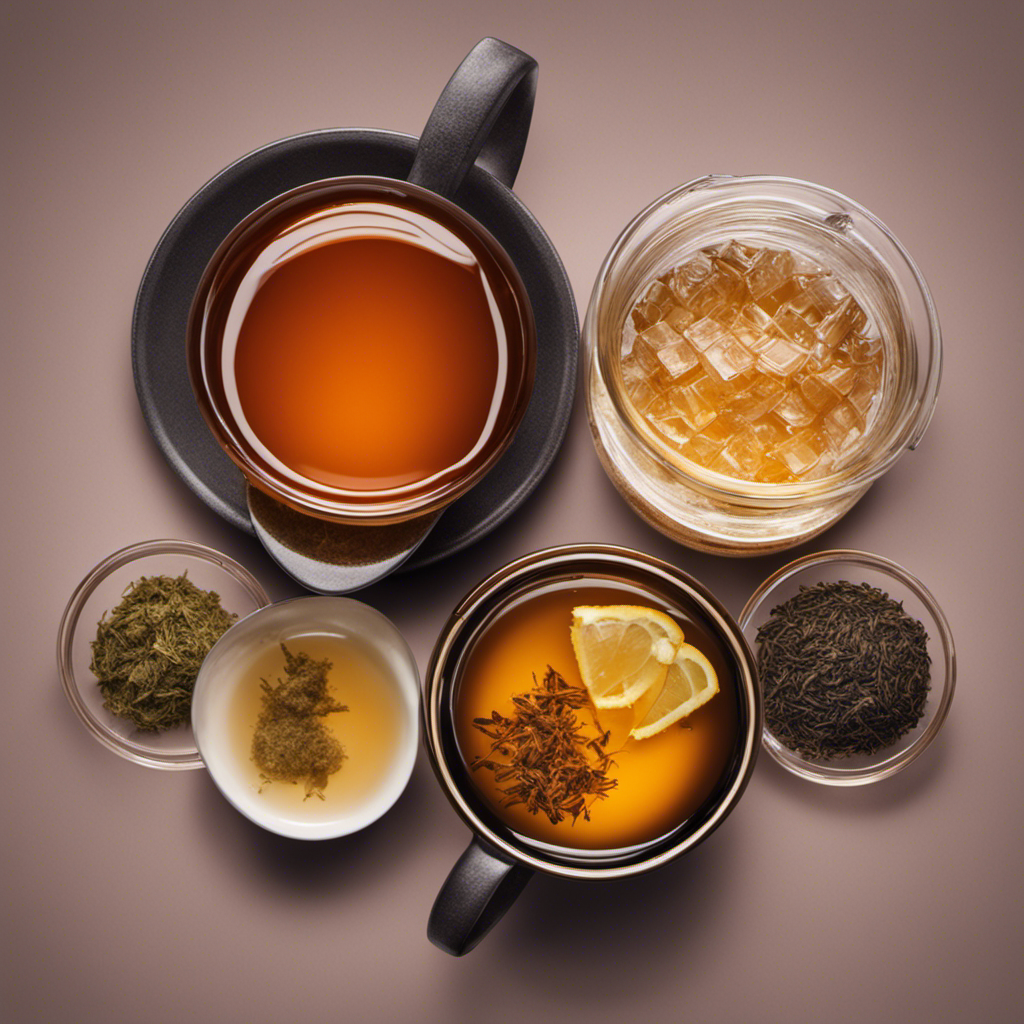Cappuccino
Milk Matters: Finding the Best Type for Perfect Cappuccino Foam

If you’re a cappuccino foam aficionado, then you know that creating the perfect foam takes more than just skill. Finding the right milk can make a world of difference! Whether you’re a barista, or a home enthusiast just starting to learn how to make your own cappuccinos, it’s important to choose the best milk for your cappuccino foam.
As an experienced cappuccino foam expert, I’ve tried and tested countless types of milk over the years. From whole milk to skimmed, organic and non-organic alike – I’ve explored them all in my quest for the perfect cup of cappuccino foam.
After many trials and errors, I’m delighted to share with you my findings on which type of milk produces the best foam for your cappuccinos. Read on as we discuss what makes each type of milk unique and why each one will help you create that perfect cup of cappuccino every time!

Types Of Milk
There is no shortage of milk options when it comes to achieving the perfect cappuccino foam. From dairy-free to dairy alternatives, you can use soy milk, oat milk, or even coconut milk. Each type of milk brings its own unique set of advantages and disadvantages when steamed for a delicious foam topping. Before deciding on the best type of milk for your cappuccino, it’s important to understand the pros and cons of each option.
For those looking for a non-dairy alternative, soy and oat milks are both excellent options. Soy milk is made from soybeans and offers all the benefits of cow’s milk without being animal-based. Oat milk is made from oats and has a smooth texture that makes it great for frothing. Coconut milk has become increasingly popular due to its creamy texture and nutty flavor. All three types of dairy-free milks are suitable alternatives if you are intolerant or prefer not to consume dairy products.
Choosing between regular dairy products and their alternatives can be tricky. Dairy milks like whole, 2%, 1% or skim can all produce a creamy foam but with subtle differences in taste and texture depending on their fat content. However, these types of milks have somewhat shorter shelf lives than their non-dairy counterparts, making them more difficult to store for longer periods of time. To get the most out of your cappuccino foam experience, it’s important to weigh up each option before making your decision. Understanding the pros and cons of each type of milk will help you pick the best one for your cappuccino foam needs! With this knowledge in hand, let’s take a look at the pros and cons of dairy milk…
Pros And Cons Of Dairy Milk
Now that we’ve looked at the types of milk available for making a cappuccino foam, let’s discuss the pros and cons of using dairy milk.
When it comes to health, dairy milk is an excellent source of protein and calcium. It also contains Vitamin D and other important nutrients. On the other hand, dairy milk can be harmful for those who are lactose intolerant or have allergies to dairy products.

Here’s a quick list on what to consider when deciding whether to use dairy milk or not:
Dairy Milk Pros
- High in protein and calcium
- Contains Vitamin D
- Healthy choice overall
Dairy Milk Cons
- Lactose intolerance
- Allergies
- Quality is dependent on where it is sourced from
In terms of quality, the source of your dairy milk matters. If you’re getting it from a local farm or grocery store, there’s less chance of contamination due to stricter regulations than if you were getting it from an overseas supplier. When considering which type of milk to use for your cappuccino foam, keep in mind these pros and cons associated with dairy milk.
Next up, we’ll look at the nutritional content of dairy alternatives such as oat, almond and coconut milks so that you can decide which one fits your needs best.
Nutritional Content Of Dairy Alternatives
Exploring the nutritional content of dairy alternatives is like a treasure hunt – you never know what you’ll find! When it comes to cappuccino foam, there are a plethora of milk variants available. Each one brings its own unique benefits and drawbacks in terms of calorie count and protein levels.
Let’s start with cow’s milk, the most popular choice for creamy foam. Cow’s milk is high in calcium and protein, making it an ideal base for a cappuccino. However, it can also be quite high in fat and calories, so if that’s something you’re looking to avoid, then almond or coconut milk may be the better option. Both contain fewer calories than cow’s milk while still providing a creamy texture for your foam.
For those who prefer to stick with dairy-based products, skimmed or semi-skimmed milks are the way to go as they are lower in fat and calories than full-fat milks. Soy milk is also worth considering as it has similar nutritional content to cow’s milk but can add an extra creaminess when used as a foaming agent.
With so many options available, there’s no right or wrong answer when choosing the best type of milk for cappuccino foam – just pick whichever one fits your dietary needs and preferences. From here, let’s take an even closer look at soy milk as a foaming agent…
Soy Milk As A Foaming Agent
Now that we’ve discussed the nutritional content of dairy alternatives let’s look into how soy milk can be used as a foaming agent. Soy milk is an excellent choice for creating cappuccino foam due to its lightness and smooth texture. It also has a neutral taste, making it ideal for enhancing the flavor of your coffee.
When using soy milk as a foaming agent, you want to start with cold or room temperature soy milk and use at least 2% fat content for optimal results. Pour two ounces of the soy milk into a metal pitcher and use an immersion blender to create some air bubbles in the liquid. If you don’t have an immersion blender, you can use a handheld frother instead. After about 15 seconds of blending, you should begin to see thick foam forming on top of your soy milk mixture. Use a spoon to scoop out any large air bubbles from the surface before pouring it into your cup of espresso or cappuccino.
For those looking for a thicker foam texture, adding sugar and/or cocoa powder can help to create that desired consistency. Simply add one teaspoon of sugar and/or cocoa powder into the soy milk before blending with either an immersion blender or frother. The sugar helps increase viscosity while the cocoa provides additional thickness and flavor complexity. With just these few simple steps, you’ll be able to make delicious cappuccino foam with soy milk in no time!
Oat milk is another great option when creating creamy textures in coffee drinks because it has more body than other plant-based milks such as almond or coconut milk. Let’s explore how oat milk can provide tasty results in our next section…

Oat Milk’s Creamy Texture
Regarding cappuccino foam, oat milk stands out for its creamy texture. Oat milk is naturally rich in proteins and creates a wonderfully smooth and silky foam. This makes it the ideal choice for creating velvety cappuccino foam with just the right amount of creaminess. The result is a light, airy foam with an irresistible smoothness that makes every sip of your cappuccino more enjoyable. It’s also worth noting that oat milk is suitable for vegans, so it can be enjoyed by everyone!
What really sets oat milk apart from other dairy alternatives when making cappuccino foam is its natural creaminess. It’s straightforward to work with and has a thick consistency that guarantees delicious results every time. That’s why baristas often recommend it as the go-to cappuccino dairy alternative. To sum up, oat milk’s creamy texture can help you create the perfect cappuccino foam that will leave your customers coming back for more.
For those looking for an even richer cappuccino experience, coconut milk is an excellent option.
Coconut Milk In Cappuccino Foam
Coconut milk is an excellent choice for a creamy, full-bodied cappuccino foam. It has a high fat content and is naturally sweet, making it ideal for this purpose. The subtle coconut flavor adds an additional layer of complexity to the drink. Plus, it contains fewer calories than cow’s milk, so it’s great for anyone looking to reduce their calorie intake.
| Milk | Calories per cup (8oz) |
|---|---|
| Cow’s Milk | 146 |
| Coconut Milk | 45 |
When using coconut milk in cappuccino foam, you may need to add a bit more sugar to counterbalance its slightly neutral taste. However, if you are looking for a healthier alternative with less sugar and fewer calories, coconut milk is definitely the way to go. You will still get the same creamy texture and rich flavor you love in your cappuccinos.
So far, we’ve discussed how coconut milk can be used as an alternative to cow’s milk when creating cappuccino foam. But what about those looking for a low-calorie option? Almond milk may be the answer.
Almond Milk For Low-Calorie Foam
For those looking for a low-calorie alternative to the traditional dairy milk used in cappuccino foam, almond milk is an excellent option. It has a naturally light and delicate flavor that pairs perfectly with the espresso and can be used to create a light and creamy foam.
As a cappuccino foam expert, I’m here to tell you that almond milk is one of the best options when it comes to creating a delicious treat without all the calories:
- Almond milk is low in calories and fat but provides enough protein for an excellent foam texture.
- The texture of almond milk is much more delicate than regular cow’s milk, making it perfect for creating light and airy froth.
- Its creamy consistency makes it ideal for creating luxurious cappuccino foam without sacrificing on taste or texture.
So if you’re looking for an alternative to traditional dairy milk that’s both low in calories and still provides great results, almond milk might be just what you need! Its subtle nutty flavour adds something special to your morning brew while its delicate texture ensures a smooth and creamy finish every time. Plus, with its low calorie content, you can enjoy your favourite drink without feeling guilty about indulging too much!
Rice Milk For Richness
Moving on from almond milk for low-calorie foam, rice milk is another popular choice for making cappuccino foam. It has a creamy texture and provides a great richness to the foam. Rice milk is much sweeter than other non-dairy milks, so it’s best used in cappuccinos that are already sweetened or when using flavored syrups. It also produces less bubbles than other non-dairy milks, resulting in a smoother and creamier foam.
When making cappuccino foam with rice milk, it’s important to use an electric frother or steamer as this will create the most consistent results. If you don’t have access to one of these tools, you can still make great cappuccino foam by using a whisk and vigorously stirring the milk while heating it in a pot over medium heat. This may take longer and the results may not be as consistent but it’s still possible to make great cappuccino foam with rice milk.
Rice milk is a great option for anyone looking for an extra creamy and rich cappuccino foam without having to add any additional ingredients. Its sweetness also makes it perfect for sweetening your coffee drinks without adding sugar or syrups. Now let’s move onto hemp milk for thickness…
Hemp Milk For Thickness
When it comes to creating the perfect cappuccino foam, the key is in the milk. Hemp milk is becoming increasingly popular for its rich and creamy texture, making it a great choice for cappuccino foam. Not only does hemp milk add thickness to the foam, but it also has a high foaming capability that helps create dense and velvety texture.
Benefits Drawbacks High Foaming Capability Lower Protein Content Adds Thickness to Foam Higher Price Point Rich and Creamy Texture No Lactose Option Available
Hemp milk adds an extra layer of creaminess and thickness to your cappuccino foam that many other types of milk cannot match. Additionally, it won’t break down as quickly as some other types of milk, so you don’t have to worry about your foam getting too thin or runny. While hemp milk can be expensive compared to other dairy-free options, its quality makes up for this drawback. Unfortunately, no lactose-free versions of hemp milk are available yet, so those with lactose sensitivities may need to look elsewhere.
Overall, hemp milk is an excellent choice for creating luxurious cappuccino foam with a thick and creamy texture. It has a high foaming capability that helps produce velvety results every time, while also adding an extra layer of richness that can’t be matched by other types of milk. Despite being more costly than other alternatives, hemp milk offers superior quality, making it worth the price. With all these benefits in mind, it’s easy to see why so many baristas swear by this type of milk when making their cappuccinos. Moving on from here we’ll discuss cashew milk for sweetness…
Cashew Milk For Sweetness
Moving on from hemp milk, cashew milk is a great option for adding sweetness to cappuccino foam. Cashew milk has a mild, nutty flavor and a creamy texture that works well in the foam. It’s especially great if you’re looking for a sweet cappuccino!
When adding sweetness to cappuccino foam, cashew milk is the way to go. It’s also lower in calories than other milks, so you can enjoy your sweet cappuccino without worrying about your waistline. Plus, you don’t have to worry about it curdling due to its low fat content.
The best part about using cashew milk for your cappuccino foam is how easily it combines with other flavors. You can mix in chocolate syrup or spices like cinnamon for even more sweetness and flavor. And of course, the creamy texture of the cashew milk adds an extra touch of indulgence that can’t be beaten. So next time you want a sweet treat in your coffee cup, reach for some cashew milk!
Frequently Asked Questions
What Type Of Milk Is Best For Cappuccino Foam?
Do you ever feel lost when making the perfect cappuccino foam? It can be daunting, especially when navigating the dairy-free and milk-types options. Well, never fear! As your cappuccino foam expert, I’m here to help you find the best option.
Let’s start by looking at nutritional content. Dairy kinds of milk are usually high in fat and protein, while non-dairy milk tends to have less of both. This can affect foaming ability, so consider that before deciding which type of milk is right for you. On the other hand, if you’re looking for a vegan or dairy-free alternative then almond, oat or soy milk may be better suited to you – although they will produce a thinner foam than cow’s milk.
The next thing to consider is whether or not the milk has an added foaming agent. These agents will make it easier to achieve a thick creamy foam without having to whisk it vigorously. However, bear in mind that these added ingredients can affect the flavor of your cappuccino too!
- Almond Milk: High in Vitamin E and low fat content
- Oat Milk: Has fewer calories than cows’ milk but more carbohydrates
- Soy Milk: Contains healthy fats and proteins
- Cow’s Milk: High in proteins and calcium
Whichever type of milk you choose for your cappuccino foam needs, just remember that all milks have different nutritional profiles and foaming abilities so it’s important to do your research and find what works best for you. The key is experimentation – so don’t be afraid to try something new! With this information at hand, I’m sure you’ll soon be whipping up delicious frothy cappuccinos like a pro!
Does Dairy Milk Create Better Cappuccino Foam Than Dairy Alternatives?
When it comes to creating the perfect cappuccino foam, it’s important to understand what type of milk is best for the job. Dairy milk and dairy alternatives both have their benefits when it comes to creating a delicious foamy cappuccino. So, does dairy milk create better cappuccino foam than dairy alternatives? As an experienced cappuccino foam expert, I’m here to share my insight!
Dairy milk such as whole or skimmed milk can be used to create a light and airy texture in your cappuccino foam. This type of milk contains some fat which helps bring out the flavor of your coffee as well as creating a thick and creamy texture in your cappuccinos. Dairy alternatives like almond, soy, and oat milks also work well when making cappuccino foam but they require a few extra steps to get the desired result. These types of milks don’t contain any fat so they will not give you that same creamy and luxurious texture as traditional dairy milks do. However, they tend to froth up nicely if you add a bit of sugar or syrup before frothing them up.
So which creates better foam? Both types of milks can be used effectively when making cappuccinos but the final decision really depends on personal preference. If you are looking for a more traditional taste with a creamy texture, then using traditional cow’s milk is probably your best bet. On the other hand, if you are looking for something lighter and less sweet then using one of the many dairy-free options may be more suitable for your needs. Ultimately, it’s all about experimenting with different types until you find what works best for you!
How Does The Nutritional Content Of The Milk Affect The Foam?
As any cappuccino foam expert knows, the nutritional content of milk is essential for creating the perfect cappuccino foam. But how exactly does it affect the end-result? That’s what this article will explore.
Let’s start by examining the composition of milk, which contains proteins and fats that create bubbles when mixed with hot water and air. The more proteins and fats present in the milk, the greater amount of bubbles are created, thus resulting in a better foam. On the other hand, if there is a lower content of proteins and fats, then it is likely that less bubbles will be formed, resulting in a subpar foam.
Now let’s look at different types of milk available to baristas for creating cappuccino foam: dairy milk and non-dairy alternatives such as soy or almond milk. Dairy milk typically has higher levels of protein than non-dairy options – making it an ideal choice for creating cappuccino foam with bigger, denser bubbles and a more voluminous texture. Non-dairy alternatives lack the same amount of proteins as dairy but can still produce good quality foams when used correctly.
So while trying to create cafe-worthy cappuccino foam at home, remember to consider the nutritional content of your chosen type of milk – whether that’s dairy or non-dairy – as it can make all the difference between an average cup and one worth bragging about!
Can Any Of The Listed Milk Types Be Used As A Foaming Agent?
When creating the perfect cappuccino foam, the right kind of milk can make all the difference. As a cappuccino foam expert, I often ask which milk types are best for foaming. The answer is that any of the listed milk types can be used as a foaming agent, though some will produce better foam quality than others.
Dairy-free and non-dairy milks have been gaining popularity lately, and for a good reason: they offer greater versatility when it comes to creating a silky foam texture. For example, almond or soy milk tends to produce more voluminous foam with better stability and texture than traditional dairy milk. That said, the type of milk you choose should depend on what flavor profile you’re aiming for – if you’re after a creamy texture with subtle sweetness, then cow’s milk is your best option.
When selecting a foaming agent for your cappuccino, it’s important to consider how each type of milk will affect the end product. Every variety has its own unique properties that can enhance or detract from the overall flavor and consistency of your foam. For instance, oat or coconut milk will create a lighter, fluffier texture while cow’s milk will give your cappuccino an extra creamy finish. Ultimately, it all comes down to personal preference – so experiment with several different types until you find one that works best for you!
Whatever type of milk you choose, following proper technique is key for achieving optimal results. Make sure to use hot (not boiling!) water when steaming and work quickly to whip up an airy foam with plenty of body before serving your cup of cappuccino perfection!
What Is The Difference Between Using Dairy And Non-Dairy Milk For Cappuccino Foam?
When it comes to cappuccino foam, there is a big difference between using dairy and non-dairy milk. As a cappuccino foam expert, I’m here to tell you why this matters.
If you’re looking for that velvety texture and beautiful design we all know and love in a cappuccino, then dairy milk is the way to go. Dairy milk contains fat which provides the necessary protein for stable foaming. It also contains lactose, which helps add sweetness and creaminess. Plus, the fat content of dairy milk can create a more stable foam with better texture.
On the other hand, non-dairy milks like almond or oat milk require some extra ingredients for foaming. To make up for the lack of fat and lactose in non-dairy milks, baristas usually add an emulsifier such as soy lecithin or xanthan gum to help stabilize the foam. Here’s a quick overview of what you need to consider when choosing between dairy and non-dairy milk:
- Dairy milk contains fat which helps create a more stable foam with better texture
- Non-dairy milk requires additional ingredients such as emulsifiers to achieve a stable foam
- Dairy milk provides sweetness and creaminess due to its lactose content
- Non-dairy milks are often lower in calories compared to dairy milks
- Dairy milks have higher levels of calcium than non-dairy milks
At the end of the day, your choice between dairy and non-dairy milks boils down to personal preference; but understanding what each type brings to the table will help ensure that you get that perfect cup of cappuccino every time!
Conclusion
As a cappuccino foam expert, I confidently say that dairy milk is the best choice for creating an exquisite cappuccino experience. Regarding frothing, dairy milk has a unique protein structure that creates the perfect texture for your foam. It also has a higher fat content than non-dairy alternatives, which helps to create a thick and creamy foam.
On the other hand, non-dairy milks can be used as foaming agents but they tend to lack the same richness and texture of dairy milk. Non-dairy options have lower fat content and different nutritional values which can affect the overall taste of your cappuccino.
In conclusion, if you are looking to create an unforgettable cappuccino experience, then dairy milk should be your go-to choice. Not only does it produce the best-tasting foam but it also provides you with all the nutritional benefits of consuming dairy products. So why not indulge in something truly special and make sure that your next cappuccino is made with quality dairy milk?
Justin is a seasoned author, coffee and tea enthusiast, and an essential member of the Cappuccino Oracle team. With a keen appreciation for the complexities of coffee, coffee alternatives, and tea, Justin has dedicated his professional career to exploring these realms and sharing his insights with readers worldwide.
Justin’s immersion in the world of coffee, coffee alternatives, and tea began at a young age, kindling a passion that extended beyond mere consumption. This love for these beverages led him to combine his talent for writing with his devotion to coffee and tea, bringing him to Cappuccino Oracle as a dedicated author.
Cappuccino
Discover the Rich History and Perfect Techniques Behind the Irresistible Cappuccino

I have always thought that a delicious cup of cappuccino has the ability to improve any day. With its bold espresso and creamy steamed milk, it’s a soothing treat that never fails to brighten my mood.
In this article, I’ll share the origins of cappuccino, a traditional recipe, and techniques for perfecting your own cup. Whether you’re a coffee connoisseur or simply enjoy a good brew, get ready to elevate your cappuccino game to new heights.
Key Takeaways
- Cappuccino originated in Italy in the 17th century and was enjoyed by the upper class.
- The name ‘cappuccino’ is believed to have come from the Capuchin friars.
- The traditional recipe consists of equal parts espresso, steamed milk, and milk foam.
- Steaming the milk at the ideal temperature and pouring it slowly creates a creamy and frothy texture.
The Origins of Cappuccino
I love learning about the origins of cappuccino and how it became such a popular coffee drink.
The history of cappuccino dates back to the 17th century in Italy. It’s believed that the name ‘cappuccino’ was derived from the Capuchin friars, who wore brown hoods that resembled the color of the coffee.
Initially, cappuccino was made with equal parts of espresso, steamed milk, and milk foam. It was a drink enjoyed by the upper class and was often served after dinner.
Over time, cappuccino spread across Europe and eventually made its way to America. Today, it has become a staple in coffee shops worldwide, reflecting the influence of Italian culture on coffee consumption around the globe.
The history and culture behind cappuccino make it a fascinating and beloved beverage.
Traditional Cappuccino Recipe
Sometimes, I like to make a traditional cappuccino using the classic recipe of equal parts espresso, steamed milk, and milk foam. This iconic drink has been a staple in coffeehouse culture for decades, known for its perfect balance of flavors and velvety texture. When crafting my cappuccino, I start by pulling a shot of rich espresso, with its bold aroma and intense flavor. Then, I carefully steam the milk to create a creamy and frothy texture. Finally, I pour the milk over the espresso, creating the perfect ratio of coffee to milk. The result is a delightful beverage that combines the strong notes of espresso with the smoothness of steamed milk. It’s no wonder that the classic cappuccino continues to be a favorite among coffee lovers in the vibrant coffeehouse culture.
Espresso Steamed Milk Milk Foam Rich Creamy Frothy
Techniques for Steaming Milk
To achieve the perfect texture, it’s important to carefully steam the milk with the correct technique. Steaming milk is a crucial step in creating a delicious cappuccino or latte.
Here are some common mistakes to avoid and some milk frothing tools to help you achieve that velvety smooth microfoam:
-
Not using fresh, cold milk: Fresh milk produces the best results, so avoid using milk that has been sitting out for too long.
-
Incorrect temperature: The ideal steaming temperature for milk is between 140-160°F. Anything above or below can affect the taste and texture.
-
Improper positioning of the steam wand: Position the steam wand slightly off-center and just below the surface of the milk to create a whirlpool effect.
-
Oversteaming: Oversteaming the milk can result in large bubbles and a thin, frothy texture. Aim for small, uniform bubbles.
-
Using the wrong frothing tools: Invest in a good quality frothing pitcher and thermometer to ensure precision and consistency in your milk steaming process.
Creative Cappuccino Variations
Experimenting with unique flavor combinations and adding a touch of creativity can elevate your cappuccino variations to new levels of deliciousness. When it comes to cappuccinos, the possibilities are endless. From classic vanilla and caramel to more adventurous flavors like lavender and gingerbread, there are plenty of options to suit every taste.
But it’s not just about the flavors; presentation is also key. Cappuccino art has become increasingly popular, with baristas showcasing their skills by creating intricate designs on the foam. Whether it’s a heart, a leaf, or even a cute animal, these little details add an extra touch of beauty to your cup.
Tips for Perfecting Your Cappuccino
I love adding a dash of cinnamon and a sprinkle of cocoa to my cappuccino, it’s the perfect way to enhance the flavor. But there’s more to a perfect cappuccino than just the taste.
Achieving the ideal foam consistency and mastering latte art techniques are essential for a truly exceptional cup of coffee. Here are some tips to help you perfect your cappuccino:
- Use fresh, high-quality espresso beans for the best flavor.
- Froth the milk to achieve a creamy and velvety texture.
- Pour the milk slowly and steadily into the espresso to create a beautiful layered effect.
- Experiment with different designs for latte art, like hearts, rosettas, or even intricate patterns.
- Practice your technique to ensure consistent and impressive results every time.
By paying attention to foam consistency and mastering latte art techniques, you can elevate your cappuccino experience and impress your friends with your barista skills.
Frequently Asked Questions
What Is the Caffeine Content in a Cup of Cappuccino?
The caffeine content in a cup of cappuccino can vary depending on the size and the type of coffee used. However, compared to other caffeinated beverages, cappuccino generally has less caffeine.
Can I Make Cappuccino Without an Espresso Machine?
Can I make cappuccino without an espresso machine? Absolutely! There are alternative methods for making cappuccino at home, such as using a French press or a handheld milk frother. It’s all about finding what works for you.
What Is the Difference Between a Cappuccino and a Latte?
The difference between a cappuccino and a latte lies in the ratios of espresso, steamed milk, and foam. While a cappuccino has equal parts of each, a latte has more steamed milk and less foam.
Are There Any Health Benefits Associated With Drinking Cappuccino?
Drinking cappuccino may have some health benefits, but it’s important to be cautious. Consuming too much can lead to potential risks, and it may also impact sleep quality. Moderation is key.
Can I Use Plant-Based Milk Alternatives for Making Cappuccino?
Yes, you can definitely use plant-based milk alternatives for making cappuccino. There are various options like almond milk, soy milk, and oat milk that can be used to create delicious and creamy alternative coffee beverages.
Conclusion
In the world of coffee, cappuccino stands as a timeless classic. Its origins, steeped in Italian tradition, have paved the way for endless creative variations. With the perfect balance of steamed milk and expertly pulled espresso, a cappuccino becomes a symphony of flavors, a rich and creamy dance on the taste buds.
So, whether you prefer a traditional recipe or a unique twist, mastering the art of cappuccino will always bring joy to your mornings.
Arf, an author and an innovative enthusiast of coffee, coffee alternatives, and tea, plays a crucial role as a contributor to the esteemed Cappuccino Oracle platform. Renowned for his curiosity and passion for these captivating beverages, Arf has carved out a unique space for himself in the world of exploration and writing. He realized that coffee, coffee alternatives, and tea are not mere drinks to keep one awake, but universes of flavors and stories waiting to be explored.
Arf’s articles for Cappuccino Oracle blend meticulous research with personal experiences, providing readers with an in-depth understanding of various types of coffee, coffee alternatives, and tea, along with their unique characteristics, cultures, and histories. His honest reviews and engaging narratives guide readers on their own journeys, helping them discover their preferences and find their perfect brew.
Cappuccino
The Cultural History Of Cappuccino: A Perfect Morning Cup

Beginning my day with a cappuccino is something I truly enjoy. Its luxurious fragrance, creamy feel, and the ideal mix of espresso, steamed milk, and foam create the perfect morning treat.
But have you ever wondered about the cultural history behind this beloved beverage? Well, let me take you on a journey through time as we explore the origins, evolution, and popularity of cappuccino.
Dating back more than 400 years, cappuccino has its roots in Austria and Italy, where it was named after the Capuchin friars. Over the years, it has transformed from a simple coffee drink to a work of art, thanks to the invention of the espresso machine.
Today, cappuccino is enjoyed not only in the morning, but throughout the day, in various settings, from local cafes to high-end coffee shops.
So, grab your favorite mug, sit back, and join me as we delve into the cultural history of cappuccino – the perfect morning cup.
Key Takeaways
- Cappuccino originated in Austria and Italy and is named after the Capuchin friars.
- The modern version of cappuccino evolved after the invention of the espresso machine.
- Cappuccino is traditionally a morning drink but is now enjoyed throughout the day.
- Cappuccino can be customized with flavorings and can be enjoyed in various settings.
Origin and Evolution
I know that cappuccino originated in Austria as kapuziner and in Italy as cappuccino, named after the Capuchin friars, and evolved into its modern form after the invention of the espresso machine. The influence of these two countries can still be seen in the way cappuccino is enjoyed today.
In Austria, the kapuziner was made with equal parts coffee and milk, while in Italy, cappuccino was made with equal parts espresso, steamed milk, and milk foam. This traditional recipe is still followed in many places, but there are also modern variations that have emerged.
Some variations include using hot milk instead of steamed milk, adding flavorings such as vanilla or caramel, or even using cream instead of milk. These variations have made cappuccino a versatile and customizable drink that can be enjoyed by coffee lovers all over the world.
Ingredients and Preparation
Crafting a cappuccino involves combining carefully measured amounts of espresso, steamed milk, and velvety milk foam. The choice of milk for a cappuccino is crucial in achieving the perfect balance of flavors and textures. Whole milk is commonly used for its creamy richness, but some prefer to use lower fat options like skim or soy milk. Each type of milk imparts a slightly different taste and texture to the cappuccino.
When it comes to flavorings, some people enjoy adding flavored syrups to their cappuccino for a touch of sweetness or a unique twist. However, there are pros and cons to using flavored syrups. On one hand, they can enhance the taste and create a more personalized experience. On the other hand, they can overpower the natural flavors of the espresso and milk. Ultimately, the decision to use flavored syrups in a cappuccino is a matter of personal preference.
Popularity and Enjoyment
To truly appreciate the popularity and enjoyment of this beloved beverage, one must delve into its cultural significance and historical roots. Cappuccino has not only gained popularity as a morning drink but has also become a symbol of the coffee culture worldwide. It has been embraced and adapted by different countries, resulting in unique variations that reflect their own cultural preferences.
Here are some examples:
1) Italy: Cappuccino is deeply ingrained in Italian culture and is commonly enjoyed with breakfast. Italians take great pride in their coffee craftsmanship and often create stunning latte art on top of their cappuccinos.
2) United States: In America, the iced cappuccino has gained immense popularity, especially during the warmer months. It is a refreshing twist on the traditional hot version and is often enjoyed as an afternoon pick-me-up.
3) Greece: Here, the frappé cappuccino is a favorite among locals and tourists alike. It is made with instant coffee, sugar, water, milk, and ice, creating a frothy and delicious drink perfect for hot summer days.
4) Australia: Australians have their own version called the ‘flat white,’ which is made with a double shot of espresso and velvety microfoam. It has gained a cult following and is considered a staple in Australian coffee culture.
These global variations highlight the cultural significance and adaptability of cappuccino, making it a beloved beverage enjoyed by people from all walks of life.
Frequently Asked Questions
How did the name "cappuccino" come about?
The name ‘cappuccino’ originated from the Italian influence and was derived from the Capuchin friars. This interesting fact reveals the historical connection between the drink and the Capuchin order, adding depth to its cultural significance.
What are some common misconceptions about cappuccino?
Some common misconceptions about cappuccino include thinking that it is only a morning drink and that it is the same as a latte. Cappuccino can be enjoyed at any time of day and has a different ratio of ingredients than a latte.
Are there any health benefits associated with drinking cappuccino?
Drinking cappuccino in moderation may have potential health benefits. Some studies suggest cappuccino may promote heart health due to its antioxidant content. Additionally, the ritual of enjoying a cappuccino can contribute to mental well-being and relaxation.
How has the cultural significance of cappuccino evolved over time?
The cultural significance of cappuccino has evolved over time. It has become more than just a morning drink, now enjoyed throughout the day. Cappuccino has also become a popular icon in popular culture, often depicted in movies and TV shows.
Are there any regional variations of cappuccino?
Oh, the regional variations of cappuccino are truly a delightful journey for the taste buds! From the rich and creamy cappuccino freddo in Italy to the indulgent iced cappuccino in America, each culture adds its own twist to this beloved beverage. The cultural significance of these variations showcases the adaptability and creativity of coffee lovers worldwide.
Arf, an author and an innovative enthusiast of coffee, coffee alternatives, and tea, plays a crucial role as a contributor to the esteemed Cappuccino Oracle platform. Renowned for his curiosity and passion for these captivating beverages, Arf has carved out a unique space for himself in the world of exploration and writing. He realized that coffee, coffee alternatives, and tea are not mere drinks to keep one awake, but universes of flavors and stories waiting to be explored.
Arf’s articles for Cappuccino Oracle blend meticulous research with personal experiences, providing readers with an in-depth understanding of various types of coffee, coffee alternatives, and tea, along with their unique characteristics, cultures, and histories. His honest reviews and engaging narratives guide readers on their own journeys, helping them discover their preferences and find their perfect brew.
Cappuccino
The Adventures of Espresso, Milk, and Foam: A Tale of Cappuccino Creation

In a parallel universe not too far from our own, the magical land of Coffeelandia is home to an array of coffee ingredients with unique personalities and desires. This is a tale of adventure and unity, where the heroes – Espresso, Milk, and Foam – come together to create the perfect cappuccino.
Chapter 1: The Bold Espresso
Espresso, a bold and intense character, resided in the heart of Coffeelandia. He was known for his daring spirit and ability to energize those around him. One day, Espresso was invited to the annual Coffeelandia Gala, where the finest coffee ingredients gathered to form the most exquisite beverages. Intrigued by the challenge, Espresso embarked on a journey to find the perfect companions to create a legendary cappuccino.

Chapter 2: The Creamy Milk
Espresso’s quest led him to Dairyland’s lush, green pastures, where he met the charming and gentle Milk. With her velvety texture and subtle sweetness, Milk was the ideal partner to balance Espresso’s intensity. Milk agreed to join Espresso on his adventure, excited to showcase her talents at the Coffeelandia Gala. Together, they set off to find the final member of their cappuccino trio.
Chapter 3: The Fluffy Foam
Upon reaching the Cloudy Peaks, Espresso and Milk encountered Foam, an airy and playful character known for his ability to bring lightness and joy to everyone he met. As they spoke with Foam, they realized that his airy nature would perfectly contrast their rich and creamy blend. Filled by the opportunity to be part of a legendary cappuccino, Foam eagerly agreed to join Espresso and Milk on their journey.
Chapter 4: The Cappuccino Trio Unites
With the trio united, Espresso, Milk, and Foam ventured back to Coffeelandia, where they practiced their harmonious collaboration. Espresso discovered that by combining his intensity with Milk’s smoothness and Foam’s lightness, they formed an extraordinary symphony of flavors and textures. They perfected their roles, with Espresso as the strong foundation, Milk as the velvety layer, and Foam as the delicate, cloud-like finish.

Chapter 5: The Coffeelandia Gala
The long-awaited night of the Coffeelandia Gala arrived, and the cappuccino trio took center stage. As they came together, their individual strengths fused into a dazzling spectacle, creating a cappuccino that enchanted the audience. The rich aroma, velvety texture, and harmonious taste mesmerized the crowd, earning them the coveted title of “The Perfect Cappuccino.”

Conclusion
The adventures of Espresso, Milk, and Foam remind us that despite our differences, unity and collaboration can lead to extraordinary creations. Their story is a testament to the power of friendship, and their legendary cappuccino will forever be remembered as a symbol of harmony in the magical land of Coffeelandia.
Noah, the Editor-in-Chief at Cappuccino Oracle, plays a pivotal role in shaping the voice and vision of our renowned platform. With an unwavering passion for coffee, coffee alternatives, and tea, Noah leads Cappuccino Oracle towards new horizons in the realm of coffee journalism.
Beyond his professional responsibilities, Noah serves as a mentor and guiding force for his team. His dedication to journalistic excellence and genuine love for coffee, coffee alternatives, and tea continue to inspire and motivate the Cappuccino Oracle family. In the ever-evolving world of these beverages, Noah’s leadership ensures that our platform remains at the forefront, delivering enlightening and enjoyable content to our readers worldwide.
-

 Americano4 weeks ago
Americano4 weeks agoHow to Make Americano With Moka Pot
-

 Americano2 weeks ago
Americano2 weeks agoHow to Make Korean Iced Americano
-

 Americano4 weeks ago
Americano4 weeks agoHow to Make Iced Americano With Instant Coffee
-

 Americano4 weeks ago
Americano4 weeks agoHow to Make Americano With Bialetti
-

 Americano4 weeks ago
Americano4 weeks agoHow to Make Dutch Bros Americano
-

 Americano6 days ago
Americano6 days agoHow to Make an Iced Americano With Nespresso
-

 Americano2 weeks ago
Americano2 weeks agoHow Many Shots of Espresso for 16 Oz Americano
-

 Americano4 weeks ago
Americano4 weeks agoHow to Make a Hazelnut Americano


















